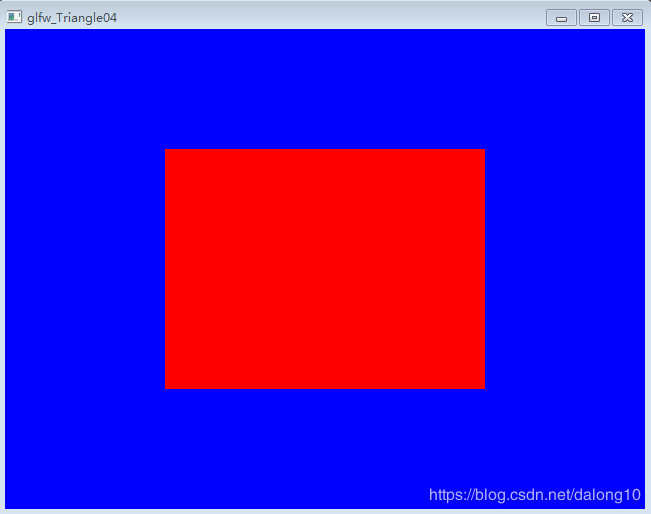Python之OpenGL笔记(6):使用EBO绘制矩形
一、目的
1、使用EBO绘制两个三角形,组成矩形图形。
二、程序运行结果
三、索引缓冲对象(Element Buffer Object,EBO)
索引缓冲对象EBO相当于OpenGL中的顶点数组的概念,是为了解决同一个顶点多次重复调用的问题,可以减少内存空间浪费,提高执行效率。当需要使用重复的顶点时,通过顶点的位置索引来调用顶点,而不是对重复的顶点信息重复记录,重复调用。
EBO中存储的内容就是顶点位置的索引indices,EBO跟VBO类似,也是在显存中的一块内存缓冲器,只不过EBO保存的是顶点的索引。
四、EBO的创建并绑定
创建EBO并绑定,用glBufferData(以GL_ELEMENT_ARRAY_BUFFER为参数)把索引存储到EBO中:
vertexData = numpy.array(vertices, numpy.float32)
self.vboID = glGenBuffers(1)
glBindBuffer(GL_ARRAY_BUFFER,self.vboID)
glBufferData(GL_ARRAY_BUFFER, 4 *len(vertexData), vertexData, GL_STATIC_DRAW)
五、绘制模型
当用EBO绑定顶点索引的方式绘制模型时,需要使用glDrawElements而不是glDrawArrays:
glDrawElements(GL_TRIANGLES, 6, GL_UNSIGNED_INT, 0);
第一个参数指定了要绘制的模式;
第二个参数指定要绘制的顶点个数;
第三个参数是索引的数据类型;
第四个参数是可选的EBO中偏移量设定。
在Python中语句是glDrawElements(GL_TRIANGLES, 6, GL_UNSIGNED_INT, None)
六、源代码
"""
glfw_Triangle04.py
Author: dalong10
Description: use EBO and Draw a TRIANGLE_FAN, learning OPENGL
"""
import glutils #Common OpenGL utilities,see glutils.py
import sys, random, math
import OpenGL
from OpenGL.GL import *
from OpenGL.GL.shaders import *
import numpy
import numpy as np
import glfw
strVS = """
#version 330 core
layout(location = 0) in vec3 position;
void main(){
gl_Position = vec4(position.x, position.y, position.z, 1.0);
}
"""
strFS = """
#version 330 core
out vec4 color;
void main(){
color = vec4(1.0, 0.0, 0.0, 1.0);
}
"""
class FourthTriangle:
def __init__(self, side):
self.side = side
# load shaders
self.program = glutils.loadShaders(strVS, strFS)
glUseProgram(self.program)
vertices = [
#// Positions
0.5, 0.5, 0, 1.0, #// Top Right
0.5, -0.5, 0, 0.0, #// Bottom Right
-0.5, -0.5, 0, 0.0, #// Bottom Left
-0.5, 0.5, 0, 1.0 #// Top Left
]
indices = [
0,1,3,
1,2,3
]
# set up vertex array object (VAO)
self.vao = glGenVertexArrays(1)
glBindVertexArray(self.vao)
# set up VBOs
vertexData = numpy.array(vertices, numpy.float32)
self.vboID = glGenBuffers(1)
glBindBuffer(GL_ARRAY_BUFFER,self.vboID)
glBufferData(GL_ARRAY_BUFFER, 4 *len(vertexData), vertexData, GL_STATIC_DRAW)
# set up EBOs
indiceData = numpy.array(indices, numpy.int32)
self.eboID = glGenBuffers(1)
glBindBuffer(GL_ELEMENT_ARRAY_BUFFER,self.eboID)
glBufferData(GL_ELEMENT_ARRAY_BUFFER, 4 *len(indiceData), indiceData, GL_STATIC_DRAW)
# Position attribute
glVertexAttribPointer(0, 4, GL_FLOAT, GL_FALSE, 0,None)
glEnableVertexAttribArray(0)
# unbind VAO
glBindVertexArray(0)
glBindBuffer(GL_ELEMENT_ARRAY_BUFFER, 0)
glBindBuffer(GL_ARRAY_BUFFER, 0)
def render(self):
# use shader
glUseProgram(self.program)
offset = 0.5
glUniform1f(glGetUniformLocation(self.program, "xOffset"), offset);
# bind VAO
glBindVertexArray(self.vao)
# draw
#glDrawArrays(GL_TRIANGLE_FAN, 0, 4)
glDrawElements(GL_TRIANGLES, 6, GL_UNSIGNED_INT, None)
# unbind VAO
glBindVertexArray(0)
if __name__ == '__main__':
import sys
import glfw
import OpenGL.GL as gl
def on_key(window, key, scancode, action, mods):
if key == glfw.KEY_ESCAPE and action == glfw.PRESS:
glfw.set_window_should_close(window,1)
# Initialize the library
if not glfw.init():
sys.exit()
# Create a windowed mode window and its OpenGL context
window = glfw.create_window(640, 480, "glfw_Triangle04", None, None)
if not window:
glfw.terminate()
sys.exit()
# Make the window's context current
glfw.make_context_current(window)
# Install a key handler
glfw.set_key_callback(window, on_key)
# Loop until the user closes the window
while not glfw.window_should_close(window):
# Render here
width, height = glfw.get_framebuffer_size(window)
ratio = width / float(height)
gl.glViewport(0, 0, width, height)
gl.glClear(gl.GL_COLOR_BUFFER_BIT)
gl.glClearColor(0.0,0.0,4.0,0.0)
firstTriangle0 = FourthTriangle(1.0)
# render
firstTriangle0.render()
# Swap front and back buffers
glfw.swap_buffers(window)
# Poll for and process events
glfw.poll_events()
glfw.terminate()
